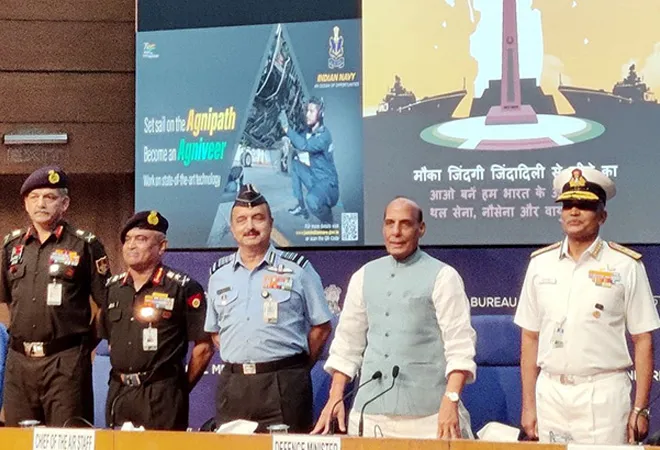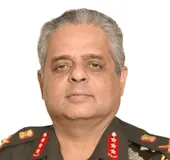 This piece is part of the essay series, The Agneepath Scheme: Radical or Irrational?
This piece is part of the essay series, The Agneepath Scheme: Radical or Irrational?
The Agnipath is, indeed, a bold, transformative reform in the Human Resource Management of the Indian Army Its salience also needs to be viewed from the lens of India’s larger national security makeover. The drivers are numerous, especially the changing national security landscape and the very nature of wars. Both, capacity building and warfighting, are becoming more complex and competitive. So much so that militaries across the world are undertaking huge reforms in ideation and strategising in the operational paradigm, in technological innovation, and also in HR to include the crafting of new talent pipelines. It may also be wise to underline the fact that as a defence in India begins to emerge from the shadows of foreign policy (a seminal occurrence), the proposed reform is a test of the capacity of the Indian Armed Forces to conceive, design, and execute change. That was after all, also the central driver in the introduction of the CDS/DMA—a major structural correction to enable an empowered Chief of Defence Staff and the Department of Military Affairs to drive change through the wider national security system. So, in the very conception of Agnipath, a larger purpose beckons.
Better models have been evolved comprising of online screening, and better aspiration—requirement matching to ensure a finer fit between the aspirations and capacities of entry seekers and the job requirements of the Armed Forces.
In terms of central tenets, the project has three modules: a recruitment module, an in-service training module, and a re-enrolment/exit module—each a major reform initiative in itself that seeks to maximise talent and combat outcomes. The current Indian recruitment methodology is somewhat dated, in that it is premised on a triad of physical testing, a written examination, and medical fitness. The world over, better models have been evolved comprising of online screening, and better aspiration—requirement matching to ensure a finer fit between the aspirations and capacities of entry seekers and the job requirements of the Armed Forces. In the Agnipath frame, we too are embracing a more nuanced model. In a similar vein, the in-service training is being infused with modern metrics—leisurely, elongated, models of the past have been reviewed, their lengths optimised, and the monies so saved will be invested in value additions like simulators, AR/VR aids, AI labs, digital curriculums, etc., to create a state of the art, training framework. In doing so, resident capacities available in our ITIs as also those created by ‘Skill India’ will be leveraged to optimise training durations and maximise outcomes. In aggregate, not only will a reformed recruitment methodology ensure qualitatively better entries, but refined training modules will ensure that the Agnivir is a superior product. The four years spent in combat deployments will reinforce the unique ethos, whilst a well-designed re-enrolment programme will ensure that only the best of the best are retained in the army. The slew of measures announced over the last week will make sure that the Agnivirs that exit is well-secured (sewanidhi) and equipped academically and vocationally (bridging courses, certificates of proficiency and competency as also accreditations with NIOS, IGNOU, RRU and a host of other universities) to sidestep into various jobs in government, paramilitary, the Indian Coast Guard, Assam Rifles, DPSUs, and the private sector with ease; the recognition of military attributes/skillsets by the All India Council For Technical Education (AICTE), the National Skill Development Corporation (NSDC), and the National Council for Vocational Education and Training (NCVET) will be enabling value additions. Those Agnivirs with entrepreneurial inclinations will be given suitable loans by public sector banks, insurance companies, and other financial institutions to fire their dreams. What persistent persuasions did not get for the Indian military over the past70 years, has metamorphosed into reality in just one week.
The four years spent in combat deployments will reinforce the unique ethos, whilst a well-designed re-enrolment programme will ensure that only the best of the best are retained in the army.
With wisdom and diligence, the Agnipath could be developed into such a foundry that it produces the finest steel—–that is the elevated purpose of the project. So, empower the Agnivirs that they are more than merely employable, but are competitive enough to thrive in the job market. The mandate of converting brand Agnivir into everyday reality must go beyond the MoD—it must be pursued by a wider set of ministries, corporate bodies, the start-up ecosystem, academia, and other institutions like Niti Aayog. If we drive the initiative with resolve, an SP in a district at some future date will seek a far larger share of Agnivirs in his constabulary as will a DM in his workforce. The Agnivir will also become the preferred choice for small and big businesses in towns and cities alike.
The talent pipeline will work like this – aspirational youth will be drawn to the folds of the army. The army will chisel them into skilled people, even as the competition for retention/enrolment will push the Agnivirs amongst themselves to reach further and higher. Those who leave will be sought after, not prostrating for jobs, but as preferred choices.
The manifestly good intent of the scheme notwithstanding, it must be ensured that the combat effectiveness of our units and formations is enhanced and not diluted in any way. Some of the apprehensions have already been addressed; steps are being taken to allay others—a better balance in the ratio of leader to the led, as also the right blend in terms of experience and youthful profile is just one facet. In such a bold and transformative reform there will of course be challenges, but none that cannot be met.
The army will chisel them into skilled people, even as the competition for retention/enrolment will push the Agnivirs amongst themselves to reach further and higher.
Certainly not when the project carries the weight of our very powerful Service Chiefs, the Defence Secretary, the NSA, the Honourable Raksha Mantri, PMO, Chief Ministers of States, the MHA, and other employment generating and enabling ministries; equally the support of some very powerful actors from the world of business—Anand Mahindra, Harsh Goenka, Kiran Shaw, Sangita Reddy, L&T, Ashok Leyland, Bharat Forge, the Amity Group to name just a few.
Agnipath is also a potential game-changer because it will help collapse these walls of granite between two cylinders of excellence—the civil and military domains of our polity. It will help to breach turfs, collapse silos, and energise talent flows. The cross flows will help uncover the many latent attributes of the military ecosystem—the wider polity and the employment system will discover that the military is far greater than merely a pool of security guards—a large slice of our soldiery are extremely proficient in organisational skills, IT, corporate operations, administration, supply chain management, communications, equipment management, computer operations, office procedures, event management, etc. Their unique attributes, namely those of loyalty, dedication, task orientation, a high sense of commitment and collaboration as also good crisis management abilities are not easy to come by. These diverse skill sets are waiting to be tapped.
The military profession, it needs to be emphasised, is as wide and deep as any other: business, law, or medicine. Its products are fused attributes of brain, brawn, wit, and wisdom. If Agniveer succeeds, deeper talent from the military will emerge, much like in the USA, Israel, China, and even Turkey, military professionals (across rank and file) will prove their utility in business, technology enterprises, finance, administration, the academia, and centres of science, to name just a few. The fusion of Saraswati (our centres of learning), Laxmi (centres of wealth creation and business), and Durga (instruments of power) will take the Indian state to new heights: Talent and meritocracy will begin to reign, allowing us to punch in accord with our strategic weight.
Agnipath, when fused with Aatmanirbharta (both the larger experiment and Aatmanirbharta in defence) will do even greater good; it will unleash the spirit of innovation, energy, and enterprise across a wider swathe of human and economic activity. It will help liberate us from the scourge of the past – a womb to tomb model of pay, pension and dependencies which compels government to grow, rather than shrink, as should be the wont.
If Agniveer succeeds, deeper talent from the military will emerge, much like in the USA, Israel, China, and even Turkey, military professionals (across rank and file) will prove their utility in business, technology enterprises, finance, administration, the academia, and centres of science, to name just a few.
The armed forces sometimes underestimate their own capacity to execute change and stay ahead of the evolutionary curve—there were equal worries when we launched the Technical Entry Scheme (TES) for officers. Today, TES products are giving NDA alumni a serious run for their money: They exist in fact in competitive equilibrium. Equal reservations were given when it came to women officers; today, the performance of lady cadets in the OTA and women recruits graduating from the CMP Centre, Bengaluru has belied all expectations. The great success of the Rashtriya Rifles was not without widespread apprehensions either; nobody today, however, disputes its signature contribution to enhancing the combat poise of the Indian Army.
If Agnipath does gather momentum and attain its full poise, in the fullness of time, the wider Indian society will be infused with a unique set of values —discipline, motivation, a can-do spirit, deliverance, innovation, and enterprise—utilitarian, not only in making our daily existence more productive but of greater salience when the Indian society is forced to respond in a crisis.
The power and purpose of the Agnipath Project, therefore, need to be absorbed and understood with some calm reflection and followed through thereafter, with resolute implementation.
The views expressed above belong to the author(s). ORF research and analyses now available on Telegram! Click here to access our curated content — blogs, longforms and interviews.



 This piece is part of the essay series,
This piece is part of the essay series,  PREV
PREV


